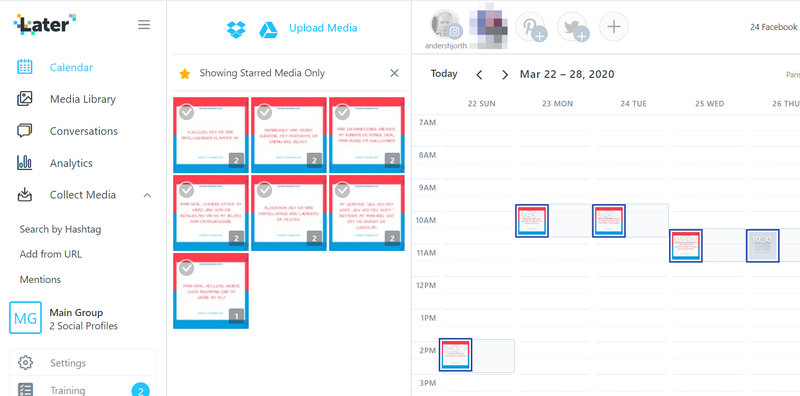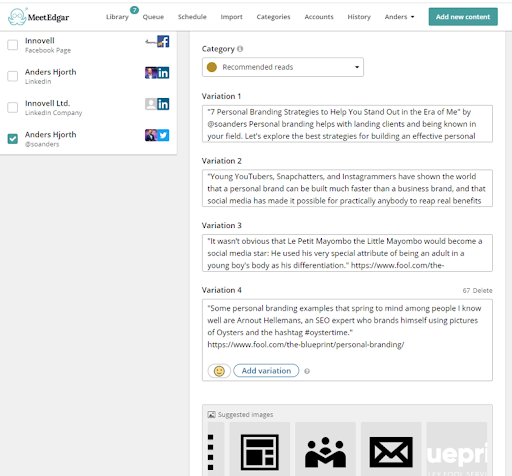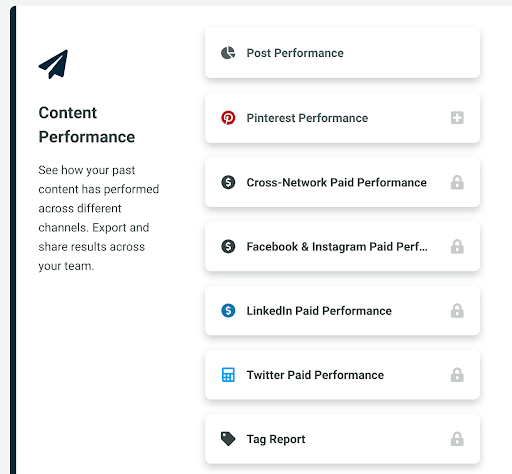By Anders Hjorth
Social media has revolutionized human relations and transformed the way we communicate. It has created a new type of celebrity thanks to the power of personal branding.
And businesses are increasingly realizing how direct person-to-person relations via digital channels can be beneficial to their sales and marketing.
To master this new type of business communication, most companies could use a bit of social media advice and some digital marketing tips. So, we’ve gathered a collection of social media tips for business in this article.
They’re easy to understand, easy to execute, and should prove valuable for any small business social media marketing operation.
8 effective social media tips for your small business:
- Learn about your audience
- Choose your primary and secondary social networks
- Use a mix of hero, hub and help content
- Repurpose your content
- Leverage inbound marketing and partnerships
- Set up social commerce
- Evolve your content from articles to video to live
- Plan and automate
8 social media marketing tips for small businesses to try
Whereas social media marketing has become an advanced marketing discipline where experts compete for excellence and for outstanding results, it’s also a playground where any business — big or small — can make a difference for itself.
The following social media marketing tips can be implemented by practically any business. (Take special note of Nos. 4 and 8, which are our favorite social media tips on this list.)
1. Learn about your audience
One of the great benefits of social media is the access to market data it provides. Social media platforms are data-driven platforms designed to tailor advertising to their users. In the process, they provide access to some of that data to businesses.
As a business owner, you’ll get access to the social media metrics you need to steer your business, but you’ll also get insights into your audience that you can use for a social media audit or for defining your target market.
How to put your audience insights into action:
While running your social media activity, you’re constantly learning more about your audience. However, you can gather audience insights for a marketing plan in a more structured way.
- Define your target: First, define what characterizes your target market. Perhaps you have several segments with different characteristics you can outline.
- Estimate segment sizes: Go to Facebook audience insights and enter the characteristics for each segment to gather an estimate of the audience size.
- Learn about their media consumption: Identify which publications your audience reads, what they watch, and who they listen to and follow on the internet by looking up their media preferences with SparkToro.
2. Choose your primary and secondary social networks
There are so many communication opportunities via social media marketing that you can easily spread your efforts too thin. By choosing one primary social network where you concentrate your efforts, you’ll get the biggest return on investment.
Other networks can be part of your small business social media strategy as secondary networks that you utilize in a more opportunistic way.
How to select your primary social network:
Sometimes the hardest thing to do is to pick one social media network and stick with it. Here’s one approach.
- Analyze the options: Analyze the user characteristics of the various social networks via information they share with you. Make a list of candidates for your primary social network.
- Compare with your target audience: Compare and contrast the characteristics of the users on each platform with the characteristics of your target audience to find the best fit.
- Evaluate your strengths: You probably have more affinities and more reach with one or more of the social networks on your list. Objectively evaluate your strengths on each platform.
- Apply weights: Set up a simple spreadsheet where you can score each social network on attractivity, audience fit, and strengths. You can weight each score to account for the most important elements. Then pick your primary network, and mark the others as secondary. Build your social media strategy around this primary social network.
3. Use a mix of hero, hub, and help content
Google has a challenge. Its advertisers were brought up with search marketing but were not necessarily educated on how to use Google’s other great advertising channel: YouTube.
Google therefore created a conceptual framework for working with YouTube. This framework helps define the role of video content, which by nature is more expensive to produce and distribute.
Whether you plan to use video or not, the YouTube strategy playbook — which uses the three Hs of “hero,” “hub,” and “help” — can be of great use when planning social media activity for your business.
How to establish your content mix:
Creating a mix of content with the three Hs is very focused on the hero content, or the driving elements of your business’s storyline that you want your broadest audience to see. Let’s look at what you need to do to establish your content mix with this in mind.
- Content audit: The first thing you need is an overview of your existing content and events that can be used in your content strategy.
- Brainstorm: The fun part of the process is the brainstorming and idea-testing for your hero content. Aim to find a unique and remarkable content idea that resonates strongly with your audience and emphasizes your brand’s differentiation.
- Plan around the hero content: Some of the other content you use in your social media strategy can be built around the hero content. Other content pieces act as “hubs” and will simply help your brand stay top of mind. And “help” content is more traditional company information that you place around and between the more story-driven hero content.
- Build a content calendar: The three types of content come together in a social media content calendar, which helps you stay organized and share your content in a consistent and effective way.
4. Repurpose your content
If you’ve followed our second tip, you may be wondering how to best utilize your secondary social networks. You may also be overwhelmed by the thought of needing to publish content to your social networks multiple times a week.
This is why content repurposing is an important strategy. A publication has a limited life span on social media, and in order to generate a return on your investment in a piece of content, you need to maximize its usage.
How to thoughtfully and effectively repurpose your content:
The initial version of your content should be optimized for your primary social network. Subsequent versions can be formatted to suit other networks, perhaps using a more visual angle, a different perspective, or simply different text.
- Optimize for your primary network: The first time you publish a piece of content, it should be optimized for your primary social network. Each social network has its own ideal mix of image, video, text, emojis, and hashtags.
- Adapt to secondary networks: You will likely need to make changes to the format of your content when publishing it on your secondary social networks. Perhaps you’ll only use parts of the content you prepared for your primary network.
- Republication: One piece of content can typically be presented several times to your primary audience. This is useful as you never reach 100% of your followers with one post since everyone is online at different times. Using different text and images for subsequent publications is a good way to make sure your content doesn’t appear stale or repetitive.
- Repurposing: Content in which you have invested significant time or money can be repurposed at a later stage. Perhaps you can update a survey you ran, provide a new editorial angle, or redo the graphics. A good way to organize the use and reuse of content is to build a social media content calendar.
5. Leverage inbound marketing and partnerships
Inbound marketing is an approach by which you create and publish content that will drive interested users closer to your offering.
It’s a structured process using planning, scoring, and automation to manage long customer interaction processes. It’s a great approach to marketing for small business, especially in the B2B space.
How to put inbound marketing into action:
Inbound marketing is about using content to drive users to your offering without reaching out to them with advertising.
- Analyze the user journey: Users travel through various stages before they become prospects for your offering. You first need to identify what questions the user is asking before they’re ready to move to the next step in the user journey.
- Create and publish content: With the stages of the user journey in mind, create content that corresponds to each stage, and think of mechanisms that will bring the user to the next stage: Newsletter subscription, whitepaper download, webinar registration, etc. This is the stage where you’ll actually use social media platforms to publish your content and engage with your audience.
- Automate the funnel: One of the aims of inbound marketing is to create an automated lead generation process. It uses content and publications on social media to generate interest and subsequently works like a content relationship management tool. You’ll need a technical solution such as HubSpot or Salesforce Pardot to pursue this approach seriously.
6. Set up social commerce
Users can be strongly influenced by social media but may not be used to buying products there. There is, however, a rising trend of social commerce on social networks like Instagram and Pinterest.
Facebook also recently launched its Page shops, adding e-commerce functionality to business pages on its platform.
How to use social commerce in your social media strategy:
Social commerce is a shortcut from social media to e-commerce. It can be an interesting opportunity for companies with strong social media activity and the possibility to sell online.
- Prepare product information: In order to sell online via social media, you need the same information as for any other e-commerce activity: product titles and descriptions, images, prices, and an order fulfillment solution.
- Choose your platform: If your primary social network has e-commerce functionality, go with that platform. If it doesn’t, consider trying one of the leading social commerce platforms: Instagram, Pinterest, or Facebook.
- Build the e-commerce functionality: It’s fairly easy to set up social commerce. Products and prices can be entered individually or as a product feed so your shop is up to date.
7. Evolve your content from articles to video to live
When you first consider content for your social media marketing plan, you might think about articles and images.
But video content has become accessible to small businesses now that platforms like the Facebook Live Producer empower you to create professional-looking live video content. You might even want to make video your hero content, as we saw in tip No. 3.
How to make smart use of video:
All you need is a smartphone with a good camera to start producing live video. We also recommend adding a good-quality microphone or headset.
- Plan your video content: For video content, you need to create a title, write a script, and find the right filming location with good lighting and an appropriate background.
- Test-run your video: To overcome the fear of looking silly and get used to speaking to the camera, do at least one test run. A teleprompter software tool can be helpful as well.
- Set it up as an event: You can create video content for later publication or create a live event. Whichever you choose, make sure to build awareness before publication to drive more views and more engagement.
8. Plan and automate
Running social media activities is about efficiently using resources. The best way to organize any social media activity is to plan ahead and automate as much as possible.
There are a number of simple social tools to help with automation that each perform specific tasks, or it can be done using a more complete social media software suite that covers all of your automation needs.
How to plan and automate your social media activity:
If you’ve built your content mix using tip No. 4, you may have started using a content calendar as the nervous system of your social media strategy. Now, all you need to do is connect your primary and secondary social networks to your content via automation.
- Define your primary social network: As described in the first tip, you should first define your social network set-up and decide where primary content goes.
- Build your content calendar: A content calendar is a key component of a social media strategy. Build your calendar by placing the hero content first and scheduling supporting content around it. You will likely have a regular flow of hub content, and the amount of help content you produce will depend on your business activity and commercial calendar.
- Automate publication: Bring it all together with automation software that allows you to connect your content to your social media accounts. Schedule posts to each of your social networks in advance, keeping your content calendar moving like a well-oiled machine.
The best social media tools for small business
Social media automation tools will help your business automate the implementation of your content strategy. In the tips above, we’ve mentioned various tasks for which these tools are useful: in implementing a content calendar, automating publications, and planning ahead.
Let’s look at a few tools that work in different ways.
1. Later
The core functionality of Later is to build a visual content calendar and schedule image posts to Instagram, Facebook, Pinterest, and Twitter. Later’s visual overview of the calendar is one of the best we’ve seen.

The content calendar view of Later is visual and well adapted to planning Instagram posts.
2. MeetEdgar
MeetEdgar is great for getting the most out of your content. It’s the content repurposing, recycling, and automation champion.

A unique feature of MeetEdgar is the automatic creation of post variations submitted for approval.
3. Sprout Social
Sprout Social is one the best and most complete social media management tools covering the entire spectrum of automation, management, research, and reporting functionalities for your social media activity.

Sprout Social provides a wide variety of reporting options, including content performance across the social media channels you are using.
Learn from what you do and focus on where you win
Most social media activity only pays off in the medium to long run, which can be frustrating to businesses looking for quick wins or a rapid return on their investment.
But some of the above tips are sure to generate value for your business even in the short run as they can help you focus on what’s essential and what tasks are the best use of your time.
Focus your efforts, optimize your content output, plan ahead, and automate where you can in order to get the most out of your small business’s social media strategy.













